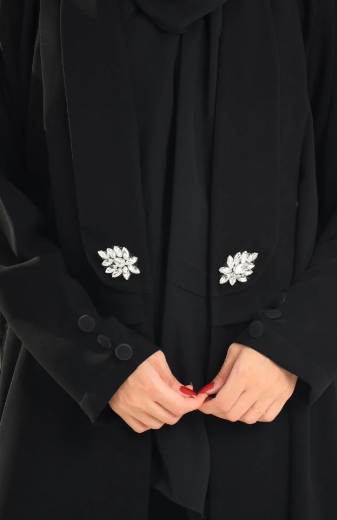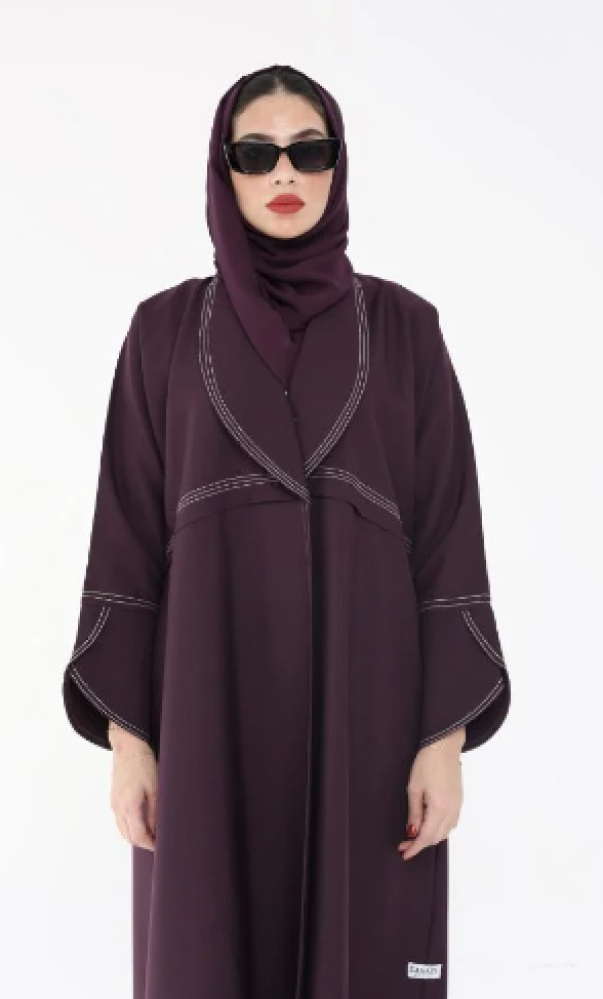Abaya names in Arabic
Abaya names in Arabic, the abaya is one of the most important traditional costumes worn by women in many Arab and Islamic countries, and is an important part of cultural heritage and identity.
Over time, the abaya has evolved to become more diverse in its designs and names, reflecting personal taste and modern fashion.
The names of abayas in Arabic vary according to their designs and shapes, reflecting the cultural diversity in different countries.
From the simple traditional abaya to the embellished abaya, and passing through the abayas that feature contemporary designs, we find that each type of these abayas has its own name that expresses its own details in terms of the cut, decoration, fabrics, and artistic touches.
In this article, we will discuss the most prominent names of abayas in the Arabic language that have spread in the Arab world, and how each name is linked to its distinctive specifications.

What are the names of abayas in Arabic?
Abayas in the Arab world vary in their designs and names, and each type is distinguished by special details that reflect the woman’s taste and the culture of society.
Here are some of the most famous names of abayas in Arabic:
- The traditional (or simple) abaya is the classic abaya with a simple, loose design, usually without distinctive embroidery or decorations.
- The embroidered abaya is characterized by hand or machine embroidery on the sleeves or edges of the abaya, and is considered one of the luxurious abayas that reflect luxury.
- The black abaya (or classic abaya) is the traditional black abaya, which represents the most prominent symbol of the abaya in many Gulf and Arab countries.
- Open Abaya (or Cardigan) An abaya open from the front with a design similar to a jacket or cardigan, and is considered a modern option that suits everyday occasions.
- A closed (or open) abaya features a closed design at the front with buttons or zippers, and covers the entire body. Some designs may have a small opening at the bottom or sleeves.
- The kimono abaya is an abaya inspired by traditional Japanese clothing, and features wide sleeves and a loose design.
- The embroidered abaya has floral or geometric patterns and motifs, making it perfect for special occasions.
- Lace Abaya uses lace or sheer fabrics to create a delicate feminine look, often for Eid or special occasions.
- A luxury (or fine) abaya is characterised by the use of high-quality fabrics such as silk or velvet, and often has gold or silver embroidery added.
- The sports abaya is a modern design that suits women who prefer comfort in their daily clothes, and is characterized by sporty patterns or details such as stripes or numbers.
These are some of the popular types of abayas, which vary between cultures and traditions, and each type reflects the woman’s taste and the occasion for which she wears the abaya.
What are the names of abayas in Arabic and how to differentiate between them?
Abaya styles vary and reflect different design styles that suit various tastes and fashion trends.
These cuts can be differentiated based on their shape, the way they are embroidered, or even the decorative details that distinguish them.
Here are the most prominent names of abayas in the Arabic language and ways to differentiate between them:
Abaya dress or long dress
- Description This cut resembles a long dress, as it flares out at the bottom and is tight or fitted at the waist.
- Differentiation This design features a dividing line at the waist or high waist, and is wider at the bottom with tight or loose sleeves.
Open abaya
- Description: It is an open abaya from the front, and it may come without buttons or with small buttons, and its shape varies between a long and short cardigan.
- The open abaya can be distinguished from other types in that it does not have a full front closure, making it suitable for informal occasions.
abaya kimono
- Description The abaya resembles a kimono in design with traditional Japanese clothing, featuring wide, open sleeves with matching hems.
- Differentiation The kimono abaya is characterized by its very wide sleeves, which are similar in design to the kimono, while the rest of the abaya is loose and parallel from top to bottom.
Open or pocket abaya (with various details)
- Description: The abaya is closed from the front but has side openings or buttons with the possibility of showing the pocket or belt.
- Differentiation This abaya has small details on the sides such as buttons or openings that show the body shape more than other fully closed abayas.
The renewed abaya (or the shiny abaya)
- Description: It features shiny details or metallic threads, and comes in new, unconventional designs such as big shoulders or ruffles.
- Distinction This abaya can be distinguished from other types by the shiny details or metallic colored fabrics that reflect light.
A-line abaya
- Description: It resembles an A-line dress, starting narrow at the shoulders and gradually widening towards the bottom.
- This abaya is usually triangular in shape, widening from top to bottom with few or no pleats, giving a streamlined look.
Circular Abaya
- Description This abaya is characterized by its circular expansion around the body, giving it a very wide shape from all directions.
- The differentiation can be distinguished thanks to its rounded shape at the bottom and the wide cylinder sleeves.
Loose (or wide) abaya
- Description: It is a loose abaya from all directions, and it is characterized by not sticking to the body.
- The distinction here is that the loose abaya is very large and not defined in shape, which gives an undefined or tight appearance.
Fuchsia or cashmere abaya
- Description Featuring luxurious fabric such as cashmere or velvet with soft details, it is more suitable for luxurious occasions.
- Differentiation This abaya is soft and elegant in design, often featuring delicate embroidery in specific colors or rich fabrics.
Abaya Sharabiya
- Description: It is an abaya made of heavy fabric suitable for cold weather, and is often surrounded by fur or wool edges.
- The distinction is easily distinguished by the thickness of the fabric and the presence of quilted edges that add extra warmth.
How to differentiate between abaya styles?
- Sizes and designs Abayas vary in size, some are tight on the body while others are loose or wide.
- Sleeves may be narrow, wide, kimono-style or straight.
- Opening and Closing Some abayas are closed in the front with buttons or zippers, while others are fully or partially open.
- Decorative details: Some abayas may contain embroidery or patterns, while others are devoid of any decoration and are characterized by simplicity.
These are some of the most prominent abaya styles and ways to differentiate between them, which allow women to choose what suits their taste and the occasion for which they wish to wear the abaya.
Names of abayas in Arabic and their features
Abayas in the Arab world are distinguished by their variety, different designs and names, and each type has its own characteristics that distinguish it from others.
Here are some of the most famous types and names of abayas in Arabic, with the features of each type:
- Traditional Abaya
- Features
- Simple and loose design.
- No elaborate embroidery or embellishments.
- Allows comfort and freedom of movement.
- It features a traditional black color that suits most occasions.
- Embroidered Abaya
- Features
- Contains hand or machine embroidery, often on the sleeves or hems.
- It adds a luxurious and beautiful touch, making it suitable for special occasions.
- They vary in colors and patterns according to the designer's embroidery.
- Open abaya (or cardigan)
- Features
- Open in the front and usually comes without buttons or with small buttons.
- Perfect for everyday or casual occasions.
- Provides freedom of movement and comfort.
- It can be coordinated with other pieces such as pants or a dress.
- Closed (or open) abaya
- Features
- Fully closed at the front, featuring a simple or ornate design.
- Provides full body coverage.
- Suitable for formal occasions and celebrations.
- May contain additional details such as zippers or buttons.
- abaya kimono
- Features
- It features wide sleeves and a loose design inspired by traditional Japanese clothing.
- It features freedom of movement and comfort.
- Its designs are modern and suit the modern woman.
- The renewed abaya (or the shiny abaya)
- Features
- Contains shiny details such as metallic threads or shiny fabrics.
- It is a luxurious choice for evening or Eid occasions.
- Reflects light and adds a touch of luxury.
- A-line abaya
- Features
- The design is narrow at the shoulders and gradually widens towards the bottom.
- It adds an elegant and modest look at the same time.
- Gives a comfortable and classy impression.
- Circular Abaya
- Features
- It features a circular design that widens from the bottom around the body.
- Gives an elegant and feminine look.
- It gives freedom of movement and is suitable for warm seasons.
- Luxury (or thin) abaya
- Features
- Made from luxurious fabrics such as silk or velvet.
- It has delicate embroidery or gold or silver details.
- Suitable for formal occasions such as weddings or grand parties.
- Lace abaya
- Features
- It features soft or sheer lace fabric, giving it a feminine and delicate touch.
- Used for special occasions such as holidays or parties.
- It is characterized by its various colors and delicate engravings.
- Sports Abaya
- Features
- Modern design for women who prefer comfort and elegance.
- Contains mathematical details such as numbers or lines.
- Suitable for casual days or even going to the gym.
Conclusion:
The names of abayas in Arabic vary in terms of fabrics, cuts, and decorations, and each type has features that make it suitable for specific occasions.
From simplicity to luxury, from traditional to modern, so that every woman can choose the abaya that suits her taste and personality, taking into account the time and occasion, as the names of abayas in Arabic help you choose what suits you.

